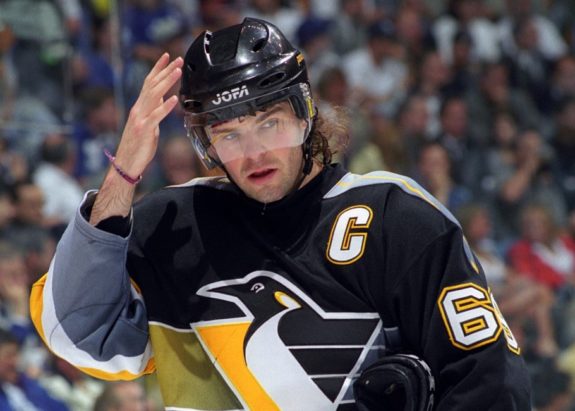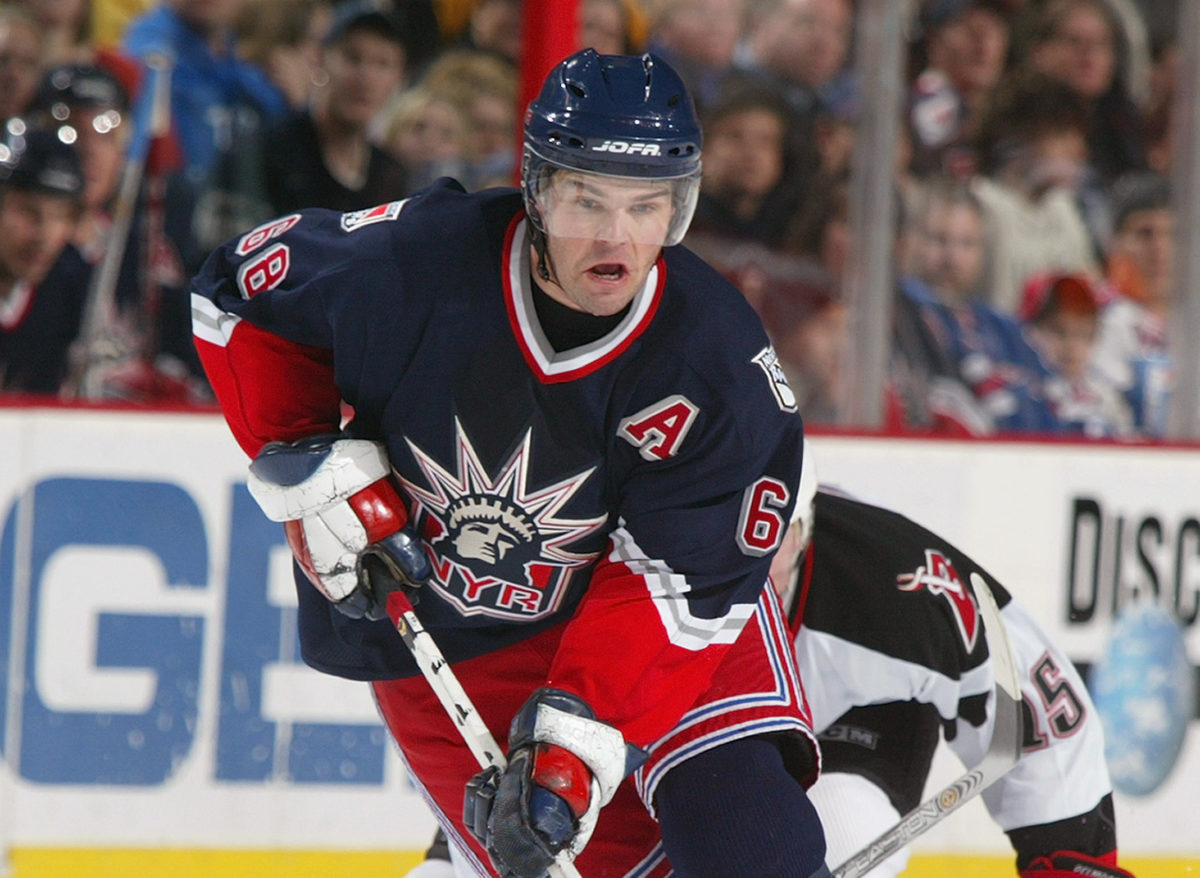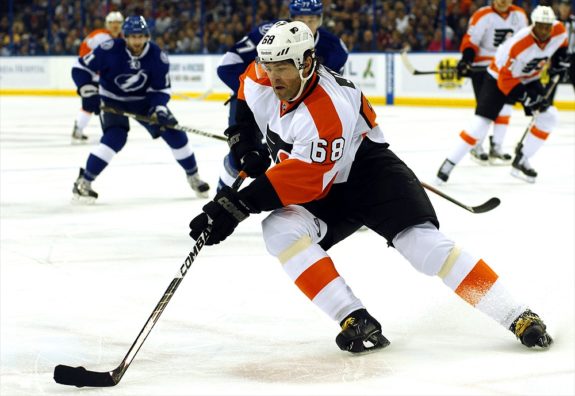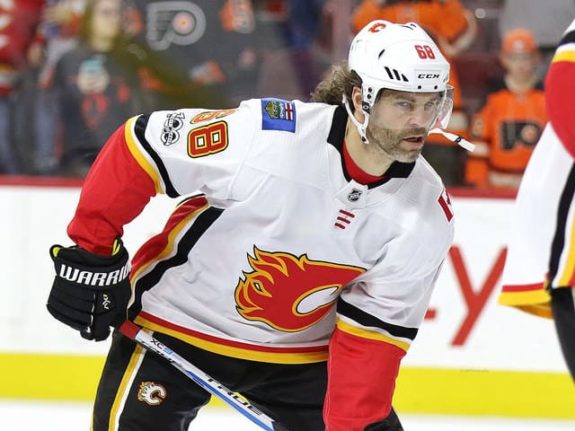One of the greatest ever in the history of hockey is Jaromir Jagr. The list of accomplishments he has is impressive. He won two Stanley Cups with the Pittsburgh Penguins in back-to-back seasons (1990-91 and 1991-92). He is second all-time in NHL history in points, only behind The Great One, Wayne Gretzky. He played in over 1,700 games in the league between nine different organizations and is a 13-time NHL All-Star. Awards he has accumulated over his storied career include being a five-time Art Ross Trophy winner, a three-time Lester B. Pearson Award winner, and being awarded with the Bill Masterton Memorial Trophy in 2016. These are just some of the things Jagr has accomplished on the ice.
The Philadelphia Flyers were one of those nine NHL clubs Jagr suited up for. He only played in one season for them, but was able to have a lasting impact on players who are still on the team to this day.
A Welcomed Return
Jagr was consistently one of the most dominant players throughout the 1990s and 2000s. He was drafted by Pittsburgh as the fifth overall pick in 1990. He grew into his own right away, making the jump to the Penguins and making a significant impact. In his first NHL campaign, he tallied 27 goals and 30 assists for 57 points in 80 regular-season games. Then he followed it up with 13 points in 24 playoff games that year (3 goals and 10 assists) in helping the Penguins win their first Stanley Cup in franchise history. He was a key piece in helping Pittsburgh successfully defend the Cup the following season as well.

Even with having as much talent around him on those Cup teams as he did (Mario Lemieux, Ron Francis, Mark Recchi, Bryan Trottier, and Paul Coffey, to name a few Hall of Famers), Jagr made a name for himself amongst them. He powered through each game with his own skill and became a legend in his own right.
Throughout the 1990s and 2000s (all the way until the end of the 2007-08 NHL season specifically), Jagr was a top player in the league for the most part. He was traded by the Penguins in the summer of 2001 along with defender Frantisek Kucera to the Washington Capitals in exchange for Kris Beech, Ross Lupaschuk, Michal Sivek, and future considerations. Jaromir then signed a seven-year, $77 million contract with the DC-based club. He only played in a few campaigns of that deal before being traded to the New York Rangers for forward Anson Carter.
You may also like:
- Frost, Tippett Handed Golden Opportunity with Flyers in 2022-23
- 3 Free Agents the Flyers Missed Out On Signing
- NHL Rumors: Canadiens, Flyers, Rangers, Oilers
- Flyers News & Rumors: Deslauriers, Braun, Lindblom, Gaudreau
- Flyers Show Internal Dysfunction on Day 1 of Free Agency
All throughout his time with all three franchises, he made the postseason in 15 out of 17 seasons he played (he made it consecutively his first 11 seasons). He chalked up the following with the Penguins, Capitals, and Rangers in the regular season:
- 1990-91 (Penguins): 27 goals and 30 assists for 57 points in 80 games
- 1991-92 (Penguins): 32 goals and 37 assists for 69 points in 70 games
- 1992-93 (Penguins): 34 goals and 60 assists for 94 points in 81 games
- 1993-94 (Penguins): 32 goals and 67 assists for 99 points in 80 games
- 1994-95 (Penguins): 32 goals and 38 assists for 70 points in 48 games
- 1995-96 (Penguins): 62 goals and 87 assists for 149 points in 82 games
- 1996-97 (Penguins): 47 goals and 48 assists for 95 points in 63 games
- 1997-98 (Penguins): 35 goals and 67 assists for 102 points in 77 games
- 1998-99 (Penguins): 44 goals and 83 assists for 127 points in 81 games
- 1999-00 (Penguins): 42 goals and 54 assists for 96 points in 63 games
- 2000-01 (Penguins): 52 goals and 69 assists for 121 points in 81 games
- 2001-02 (Capitals): 31 goals and 48 assists for 79 points in 69 games
- 2002-03 (Capitals): 36 goals and 41 assists for 77 points in 75 games
- 2003-04 (Capitals): 16 goals and 29 assists for 45 points in 46 games
- 2003-04 (Rangers): 15 goals and 14 assists for 29 points in 31 games
- 2005-06 (Rangers): 54 goals and 69 assists for 123 points in 82 games
- 2006-07 (Rangers): 30 goals and 66 assists for 96 points in 82 games
- 2007-08 (Rangers): 25 goals and 46 assists for 71 points in 82 games

Following the 2007-08 season in New York, Jagr became a free agent. Instead of signing with another NHL team, he went overseas and inked a deal with Avangard Omsk of the Kontinental Hockey League (KHL). There was speculation about him finishing his hockey career elsewhere. It was unknown whether Jaromir was officially done with the NHL altogether, or whether he would eventually make his return.
After three solid seasons with Omsk, Jagr finally decided to come back and join the NHL again. He chose Philadelphia as the city to make his comeback, signing a one-year contract worth $3.3 million. It was a question of how big of an impact he was going to make to the organization and the league.
His Year in the City of Brotherly Love
Jagr looked like he had never left the NHL the way he played for the Flyers in 2011-12. In 73 regular season contests, he posted 19 goals and 35 assists for 54 points. He was one signing in what was a busy offseason for then-general manager Paul Holmgren. Other moves made for Philly included trading star forwards Jeff Carter (to the Columbus Blue Jackets) and Mike Richards (to the Los Angeles Kings) to bring in a combined haul of Wayne Simmonds, Brayden Schenn, Jakub Voracek, a first and third-round pick in 2011, and a 2012 second-round pick. Sean Couturier was drafted as the club’s first-round pick that summer, and he made his NHL debut in 2011-12. Holmgren also brought in center Max Talbot and defenseman Andreas Lilja in free agency.

One of the most important aspects of bringing in a veteran as experienced as Jagr is the impact it has on the locker room, especially for the younger players. By the time Jaromir exited the NHL, there were players in the league who were born after he won his two Stanley Cups in Pittsburgh. That is how storied of a career he has had.
There were some younger players in that locker room in Philadelphia back in 2011-12. Couturier, as previously mentioned, had just been drafted earlier in 2011, and was 19 years old. Giroux was 24, Schenn was 20, Simmonds was 23, and both James van Riemsdyk and Voracek were 22. All were at the age where they could be taught by a veteran on how to prepare and approach the game. Those players could not have had a better mentor during that campaign based on Jagr’s resume. Part of the reason players like Giroux, Voracek, and van Riemsdyk have had impactful success during their time in the City of Brotherly Love can be attributed to Jaromir’s time with the club.
Voracek especially was impacted by Jagr’s presence on the team, but the impact with him goes beyond their stint together in 2011-12. Both Jakub and Jaromir are from the city of Kladno in the Czech Republic, and Jakub grew up watching Jaromir on TV and idolized him. He got to meet Jaromir when he was a little kid and had his picture taken with him, played with him during the 2010 IIHF World Championship, and they both had the same agent Petr Svoboda when both found their ways to Philly. Jaromir has been a key player in Jakub’s hockey life, and that became even more the case as teammates on the Flyers.

As Voracek wrote in an article on the Flyers website in 2016, he was able to take away quite a bit from being around Jagr:
“Being teammates with Jagr, watching him every day, what stands out is his preparation for the game, his passion for the game. It’s something that not everybody has,” Voracek explained in the piece. “He’s been a great example for the young guys, and for the older guys as well, watching him work, see how long they can keep up with him. The practices, the attitude towards people. It’s incredible.”
During the 2012 playoffs, Jagr notched a goal and seven assists in 11 contests. The Flyers defeated the Penguins in the Eastern Conference quarterfinal-round 4-2, before being eliminated in the semifinals by the New Jersey Devils in a 4-1 series. At the end of that postseason run, Jaromir finished sixth in scoring (eight points) behind Giroux (17 points), Danny Briere (13 points), Voracek (10 points), Schenn (nine points), and tied with Scott Hartnell with eight points himself. In the regular season that year, he finished third in team scoring (54 points) behind only Giroux (93 points) and Hartnell (67 points).
Remaining Career Stints
Jagr left Philly as a free agent, and signed a contract with the Dallas Stars. He went on to play for Dallas, the Boston Bruins, the Devils, Florida Panthers, and Calgary Flames. He then left the NHL and went to play in the Czech Republic during the 2017-18 season. To this day, at the age of 49 (his birthday was Feb. 15), Jaromir is still playing pro hockey. He suits up for the Czech Extraliga team in Kladno. Jaromir played in a total of 1,733 regular-season games in the NHL, and put up 1,921 points. As previously mentioned, that is good enough to be second all-time in NHL points behind Gretzky.

Jagr has no doubt left a tremendous impact on the game of hockey. He is one of the best to ever lace the skates, and his legacy will be felt in the NHL for many years to come based on the number of former teammates he impacted. Flyers players Giroux, Voracek, and van Riemsdyk are just a few of them from when he was in the league, and they all have been leaders in their own way for the club during their tenures since. Jaromir may have only been in Philadelphia for one campaign, but what he did for the organization during that time lasted longer, and even to this day.
